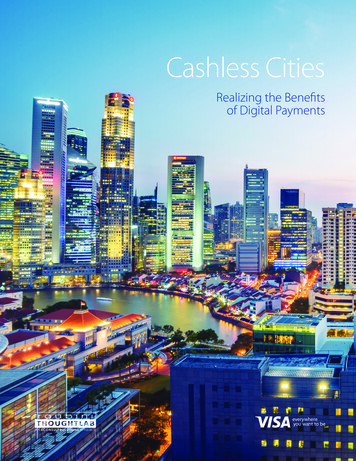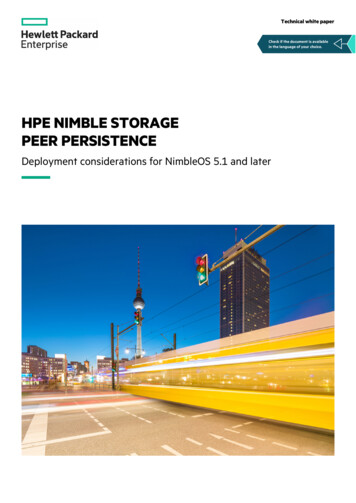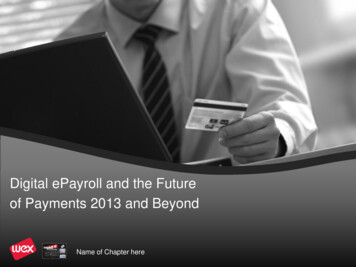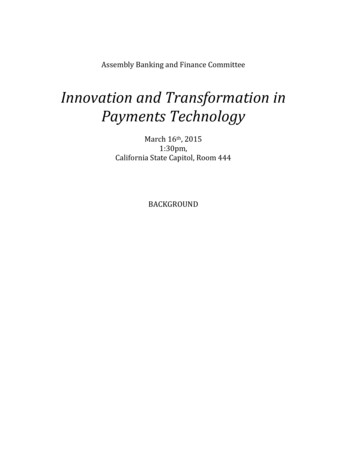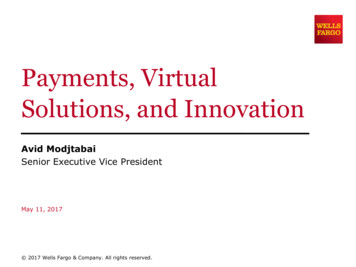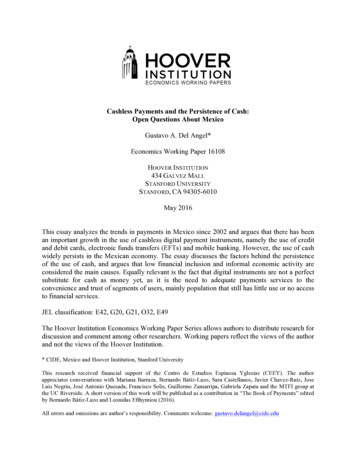
Transcription
Cashless Payments and the Persistence of Cash:Open Questions About MexicoGustavo A. Del Angel*Economics Working Paper 16108HOOVER INSTITUTION434 GALVEZ MALLSTANFORD UNIVERSITYSTANFORD, CA 94305-6010May 2016This essay analyzes the trends in payments in Mexico since 2002 and argues that there has beenan important growth in the use of cashless digital payment instruments, namely the use of creditand debit cards, electronic funds transfers (EFTs) and mobile banking. However, the use of cashwidely persists in the Mexican economy. The essay discusses the factors behind the persistenceof the use of cash, and argues that low financial inclusion and informal economic activity areconsidered the main causes. Equally relevant is the fact that digital instruments are not a perfectsubstitute for cash as money yet, as it is the need to adequate payments services to theconvenience and trust of segments of users, mainly population that still has little use or no accessto financial services.JEL classification: E42, G20, G21, O32, E49The Hoover Institution Economics Working Paper Series allows authors to distribute research fordiscussion and comment among other researchers. Working papers reflect the views of the authorand not the views of the Hoover Institution.* CIDE, Mexico and Hoover Institution, Stanford UniversityThis research received financial support of the Centro de Estudios Espinosa Yglesias (CEEY). The authorappreciates conversations with Mariana Barraza, Bernardo Bátiz-Lazo, Sara Castellanos, Javier Chavez-Ruiz, JoseLuis Negrin, José Antonio Quesada, Francisco Solis, Guillermo Zamarripa, Gabriela Zapata and the MTFI group atthe UC Riverside. A short version of this work will be published as a contribution in “The Book of Payments” editedby Bernardo Bátiz-Lazo and Leonidas Efthymiou (2016).All errors and omissions are author’s responsibility. Comments welcome: gustavo.delangel@cide.edu
1. IntroductionIn recent years, Mexico has undergone strong growth in the use of cashless payment instruments,namely the use of credit and debit cards, electronic funds transfers (EFTs) and mobile banking.Although these payment instruments have been available in the country for some time (the bankcredit card was introduced in the sixties), their rate of adoption was not remarkably fast, exceptover the last 15 years. The recent acceleration is due to the drive of the financial industry toadopt digital innovations in payments and penetrate into new market segments, mainly lowincome earners with little or no access to financial services, as well as growing interest from thegovernment to encourage digital payment methods. But despite the large increase in the use ofthese instruments over the last decade, the use of cash still persists in the Mexican economy. Thisessay seeks to document this phenomenon and discuss some hypotheses on why things havehappened that way.In Mexico the growth of cashless payment instruments, combined with the persistent use of cash,presents us with an interesting environment to discuss the coexistence of several forms to carryout transactions.1 Such coexistence, alongside with the rapid pace of innovation in payments anddigital financial services, is transforming the ecosystem of payments in Mexico. A particularcountry case might contribute to better understand developments witnessed in other nations.There are several reasons why cash persists. This essay shows the trends in payments since 2002and argues that there are three groups of causes. The first group relates to low financial inclusion,which hinders the use of digital financial services. Low financial inclusion is related at least totwo underlying factors; one is the structure and scope of the networks of payments, and the otheris the presence of a large informal economy. The second group is the extent to which digitalpayments work as money, and consequently can substitute cash. I argue that so far, there is nofull substitute for cash as money. The third is that the design of payment services still requires to1This text refers to cashless payment instruments primarily as cards, electronic funds transfers and mobile bankingthat nowadays are associated to digital technology. However, cashless payments can take many forms, for instancepayments with vouchers, checks (also discussed in this paper) and local monies. Cash, for the sake of clarity, iscoins and banknotes issued by a central bank and function as legal tender.1
prove convenience and reliability to various segments of the population, particularly those withlow financial inclusion.Moreover, we cannot expect an instantaneous and even transformation of payment practices ofall individuals. A change in habits will take more time. Some authors suggest that these habitsevolve slowly (Maurer 2015; Conolly and Stavins 2015; Bátiz-Lazo, Haigh and Stearns 2014).Change of habits also differ among distinct segments of population.New instruments, product of innovation, provide more efficient and secure means fortransactions, at least this is believed for certain contexts. Consequently, the persistence of cashpuzzles advocates of digital payments. Mazzota and Chakravorti (2014) argue that “Mexicansare reluctant to adopt new payment methods. For everyday purchases and for important bills,Mexicans trust cash.” These authors explain that the preference for cash in Mexico bearssignificant costs, and they estimate that the costs of cash access represent 2.3 billion of MexicanPesos and 48 million hours of time annually. But the coexistence of several payment methods isa rule rather than an exception, across cultures and along history. Maurer (2015) and Maurer andNelms (2014) discuss how people in the world use diverse types of monies and forms ofpayment; money is embedded in culture, social interactions and hence payments are decisionsthat contain an inherent complexity. A recent study by Sanford (2016), using the information ofthe financial diaries, shows that the poor in Mexico use a mixture of financial services thatinclude formal intermediaries as well as informal mechanisms; this includes transactionalaccounts in banks and savings cooperatives.I emphasize in this paper that more research is needed to analyze this issue. However, no singlediscipline can provide a complete answer, because the problems at stake are at the intersection offinancial inclusion, financial development, technological innovation and cultural change. Thereis no need to clarify to the reader that the expansion of the digital world has been a central factorin the growth of cashless payments and its blooming wave of innovation. And as Villasenor,West and Lewis (2015) show in a multi-country study, financial inclusion is increasingly relatedto digital inclusion.Industry studies stresses the role of technology-driven innovation. PwC assessment of the futureof the financial sector (2016 and 2014) points out that technological change is re-shapingfinancial services, creating new competitive pressures and transforming the way financialintermediaries engage with their customers. The Fintech surge has had a particular impact,2
modifying the ways in which the financial industry is approaching to innovation. However, newpreferences and needs are also result of social and demographic changes in both, emerging anddeveloped economies. Thus financial services need to adapt to a transforming culture of howpeople pays.2The paper is organized as follows. Next section argues that the expansion of digital paymentsand the persistence in the use of cash is a question observed globally. Section 3 provides a briefaccount of some key components in the formation of the payment system in Mexico which willhelp us to understand its current set-up. The following section explains how innovations aretransforming payment services. Section 5 explains the trends in the use of payment instruments,both cashless and cash. Section 6 discusses some hypotheses concerning the persistent use ofcash and the limitations of cashless instruments. Lastly, concluding remarks are provided.2. Two sides of the same coinAccording to the World Payments Report, global non-cash transactions volumes reached 357.9billion in 2013, a 7.6 percent annual growth. The fastest rate of growth was 37.7 percent inemerging Asia, led by China. In Latin America, they grew 8.6 percent, a decrease consideringthe 11 percent of the previous year. This was due to a reduction in non-cash payments in Mexicoand a slowdown in Argentina and Brazil. That report shows that Latin America accounted for23.8 billion dollars in 2009 and 35.3 billion in 2013. In the region, Brazil was the leader and it isone of the world top ten markets in 2013, with 26 billion USD that year. The growth of non-cashtransactions is led by card instruments; its share in 2013 was 62.8 percent.3 But even thoughcashless payments are growing rapidly across the world, the use of cash remains resilient. Globaldemand for cash grew 8.9% between 2009 and 2013.4Hence, there are two sides of the same coin in this process. On the one hand, cashless paymentmethods have been rising. On the other, cash remains central in payments. And this is equallyvalid for both, developed and developing economies. In a multi-country study, Amromin andChakravorti (2009) observe that despite the strong growth in the adoption of electronic payments2For changing trends in the industry see PwC (2016) and (2014).World Payments Report (2015), pp. 6-10.4According to data from Retail Banking Research, see Bátiz-Lazo, Efthymiou and Michael (2015), “Around theworld in 80 payments – global moves to a cashless economy”, in The Conversation: http://theconversation.com.33
throughout the 1990s and the early part of the twenty-first century, cash usage remainssignificant in most OECD countries. They find that greater consolidation in the retail industryalso contributes to lower transactional demand for cash, suggesting that larger merchants may bebetter able to absorb the fixed costs of accepting electronic payments.The prevalence of cash is also observed in financial systems that have led the innovation inpayments. According to Bennett, Conover, O’Brien, and Advincula (2014), in the United States,cash makes up the single largest share of consumer transaction activity, 40 percent, followed bydebit cards, 25 percent, and credit cards, 17 percent. This is because consumers have a largenumber of low-value transactions and use cash for these payments. About one-third of theaverage consumer’s monthly payments involve transactions less than 10 USD, and the averageconsumer uses cash for two-thirds of these transactions. Using data from the 2012 Diary ofConsumer Payment Choice, Briglevics and Schuh (2014) estimate payment instrument choice forU.S. consumers and find that checks have virtually disappeared from purchase transactions,while still play a role in bill payments; cash, however, still plays a relevant role for low-valuetransactions. Conolly and Stavins (2015) show that age, education and income are stronglycorrelated with the choice of payments methods; they also argue that payment behavior evolvesslowly over time.In most nations, but particularly in developing economies, the use of digital payment methodshas been linked to financial inclusion. Their use is commonly attributed to levels of inclusion;and vice versa, their greater use is considered a factor for increasing inclusion. Theunderstanding of this relationship has defined an important part of the policy debate (Villasenor,West and Lewis 2015).5 This is the case of Mexico; although it is considered an upper middleincome developing economy (it is the 15th largest world economy) which also happens to have asophisticated financial system and well-developed telecommunications sector, the level offinancial inclusion is low.Another important cause is the presence of what is called the informal economy. It is argued thatthe informal economic activity incentives the use of cash to avoid reporting or surveillance fromauthorities, mostly tax compliance. Informal activities include the underground economy, whichrefers to illegal trades and criminal activity. However, most of the informal economy is not5See Villasenor, West and Lewis (2015); and the National Survey on Financial Inclusion (Encuesta Nacional deInclusión Financiera) by the National Banking and Securities Commission (Comisión Nacional Bancaria y deValores, CNBV).4
underground, illegal, but mostly unregistered. In this view, advocates of cashless instrumentsdisplay an implicit discourse of control, which runs against the individual privacy that cashallows in transactions. Transactions in cash after all, are private.As it will be discussed in this paper, acceptance also depends on the attributes of cashlessinstruments to function as money. These attributes depend on how people use different types ofmoney for distinct purposes, depending on the size or type of transactions, cultural norms andmulti-level decision making (Briglevics and Schuh 2014; Maurer 2015).3. FoundationsThis story of the modern payments system in Mexico started with the computerization process ofbanks, which took off during the sixties.6 The introduction of the bank credit card in 1968 provedto be a milestone; its acceptance was rapid, despite its relatively limited scope which, up until thenineties, only reached medium and high income segments. 7 The development of privateplatforms in the financial system paved the way for the necessary infrastructure to distributefinancial services; in other words, the “roads and pipelines” that would allow the distribution anduse of instruments such as cards.Compared to other economies, the adoption of cashless payments in Mexico progressed slowly.This was due in part to the somewhat turbulent recent history of the financial system. Thegovernment expropriated the banks in 1982 in response to a severe and prolonged financial crisis(the Latin American sovereign debt crisis which lasted
According to the World Payments Report, global non-cash transactions volumes reached 357.9 billion in 2013, a 7.6 percent annual growth. The fastest rate of growth was 37.7 percent in emerging Asia, led by China. In Latin America, they grew 8.6 percent, a decrease considering the 11 percent of the previous year. This was due to a reduction in non-cash payments in Mexico and a slowdown in .
